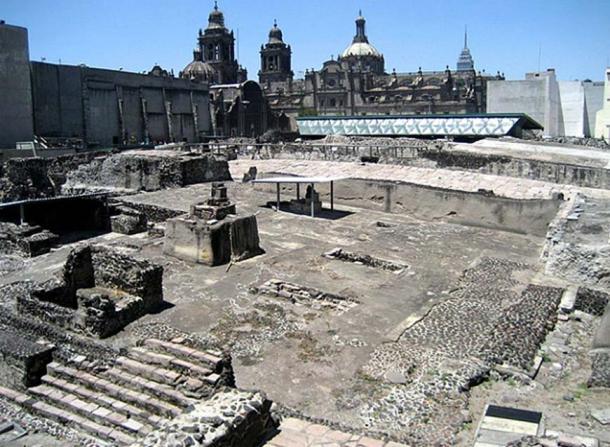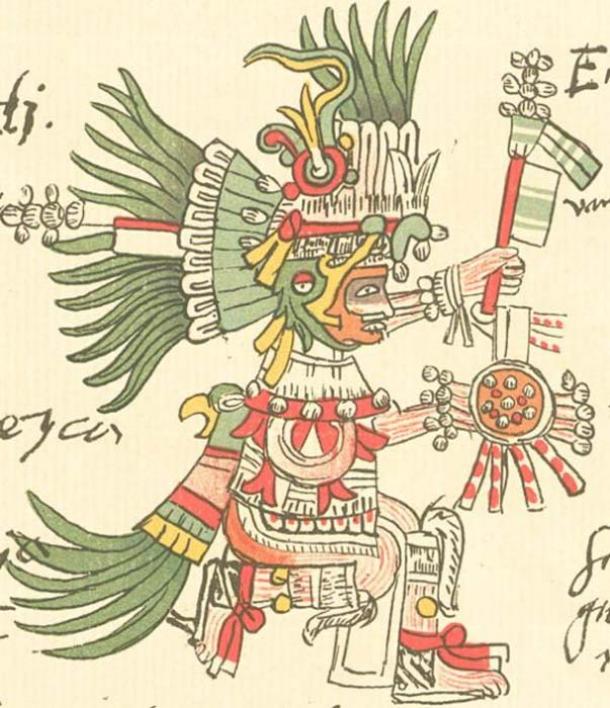By Theodoros Karasavvas
Ancient Origins
Archaeologists have discovered a sacrificial wolf carefully adorned with some of the best quality Aztec gold ever found. It is believed that the wolf was buried more than five centuries ago in the heart of downtown Mexico City, once a thriving, cultural center of the Aztec Empire.
Impressive Treasure Includes Unique Offerings
Experts can’t hide their excitement and fascination with the high quality and number of golden ornaments found. The new find includes 22 complete pieces such as symbol-laden pendants, a nose ring and a chest plate, all made from thin sheets of gold as lead archaeologist Leonardo Lopez told Reuters. Positioned in a stone box, the valuable treasure was discovered in April near the capital city’s busy main square, the Zocalo, behind the colonial-era Roman Catholic cathedral and off the steps of what was once the most significant Aztec ceremonial temple, now known as the Templo Mayor. “These are, without a doubt, the largest and most refined pieces of gold discovered so far,” Lopez told Reuters, describing the value of the 205 offerings discovered over nearly four decades of excavations around the site, sixteen of which have contained some gold.

The remains of Templo Mayor in Mexico city (CC by SA 3.0)
The Aztec Sacred Treasures
Excavations launched in the area after the destruction of two buildings that once covered the site. Measuring about 12-1/2 cubic feet, the trove also included other layers of once-living offerings from the air, land and sea, all filled with spiritual meaning for the Aztecs, “What they’re doing is they’re communicating with those levels of the environment that they live in because they know that they’ve been given the gift of life,” David Carrasco, a Harvard University historian of religion and Aztec investigator, told Reuters.
The box was damaged in 1900 when an underground carriage system was laid down next to it. Lopez speculates that city workers probably had no clue of what lay inside, “If they had seen the golden objects, they would have ransacked it right away,” he told Reuters. The Aztecs valued gold and considered it sacred, but once the Spaniards invaded, most of their gold was looted and melted into bars in order to be transported to Europe more easily. Furthermore, artifacts created by jade and feathers of the quetzal were considered even more valuable than the golden ones. Quetzal birds were greatly respected by the Aztecs. They are native birds to Central America and have iridescent green or golden-green wing coverts, back, chest and head, with a red belly.
The Cultural Significance of the Wolf’s Sacrifice
Lopez went on explaining that the wolf was around eight-month-old when it was killed and soon after it was sacrificed, the animal was decorated with golden ornaments, as well as a belt of shells from the Atlantic Ocean. Next it was elaborately positioned in a stone box by Aztec priests above a layer of flint knives. The west-facing wolf depicted Huitzilopochtli (the Aztec war god and solar deity), and the selection of the specific animal wasn’t coincidental at all, as Aztecs believed that wolves helped to guide fallen warriors across a dangerous river in the netherworld.

Huitzilopochtli, as depicted in the Codex Telleriano-Remensis. (public domain)
It is estimated that the golden wolf was buried during the 1486-1502 reign of King Ahuitzotl, one of the most intimidating and dominant rulers of the Mexica, who expanded the empire as far south as present-day Guatemala. Historians describe the reign of Ahuitzotl as excessively violent and brutal, which could possibly connect in someway with the sacrifice of the young wolf.
Lopez said further examination of the animal’s ribs will be needed in order to determine if the young wolf’s heart was torn out as part of the sacrifice, just like captured warriors were ritually killed on blood-soaked platforms of Aztec temples. But this was no coincidental or ordinary violence, according to Carrasco, “These people didn’t just kill these things. They didn’t just kill people and throw them away,” he told Reuters. And added, “They took elaborate, symbolic care for them because they knew that the presence that they represented, the presence of god, had to be nurtured.”
Top image: Alejandra Molina, an archaeologist with the National Institute of Anthropology and History (INAH), works at a site where a sacrificed young wolf elaborately adorned with some of the finest Aztec gold has been discovered adjacent to the Templo Mayor, one of the main Aztec temples, in Mexico City, Mexico. Picture credit: REUTERS/Henry Romero



